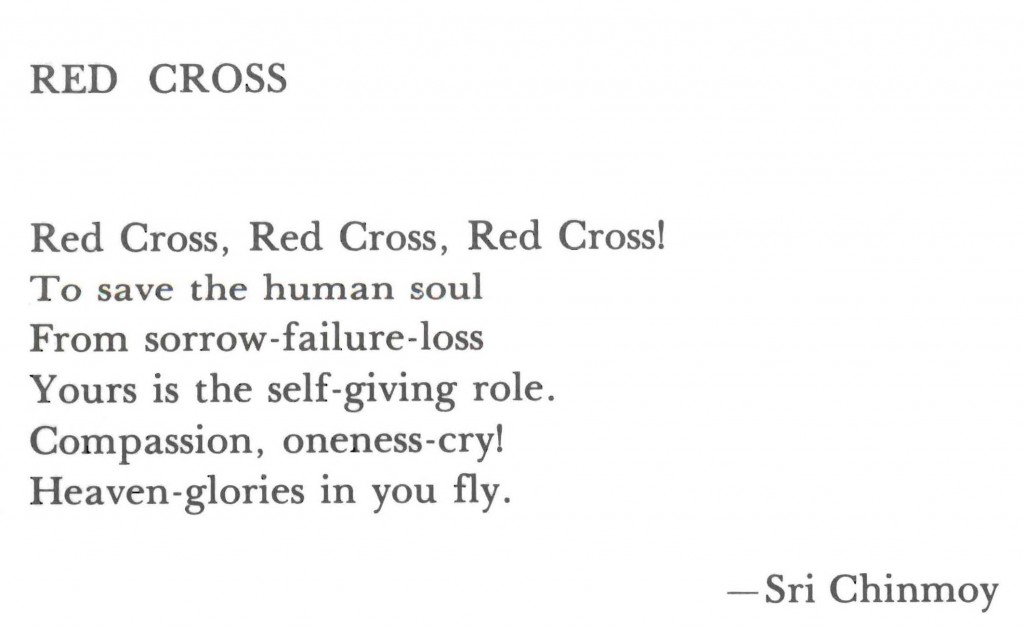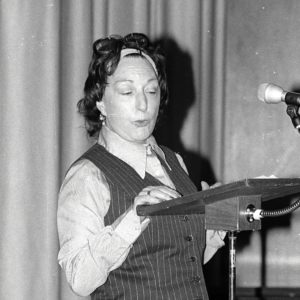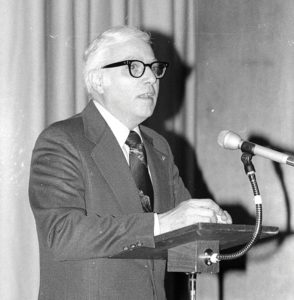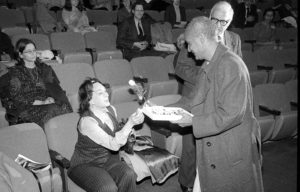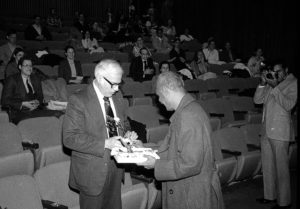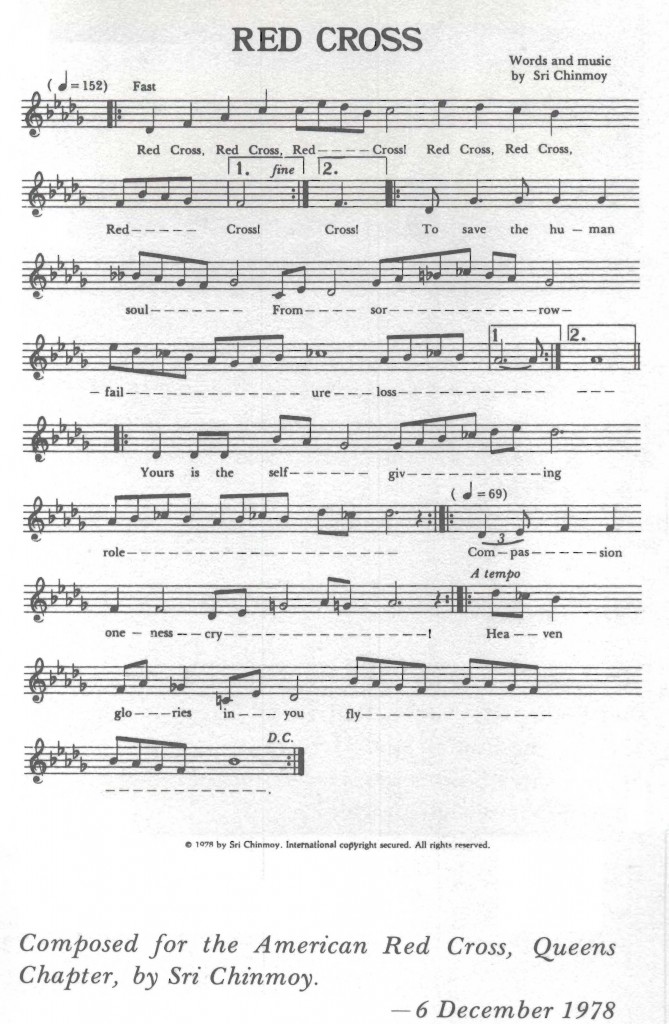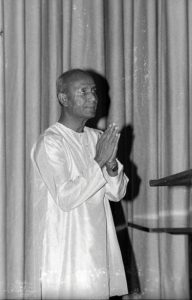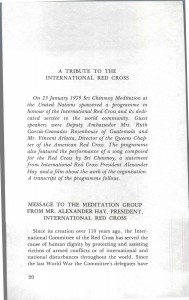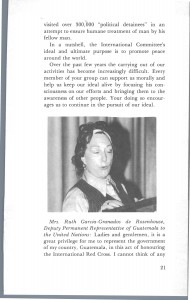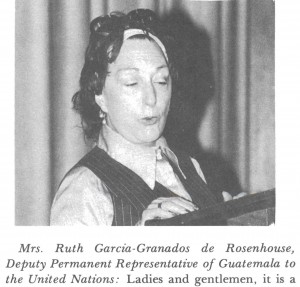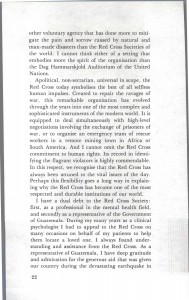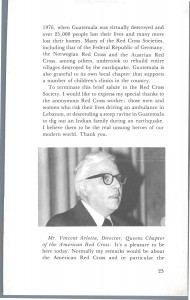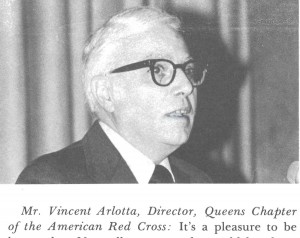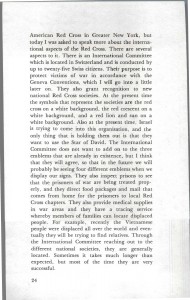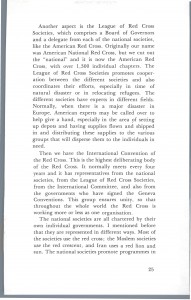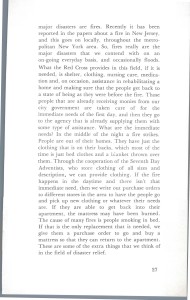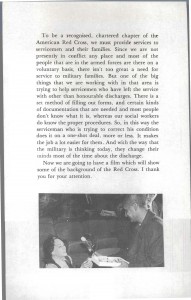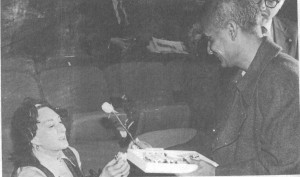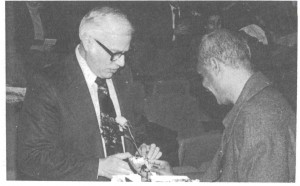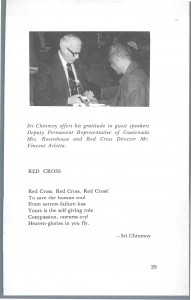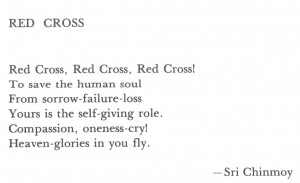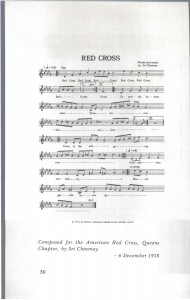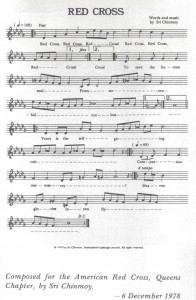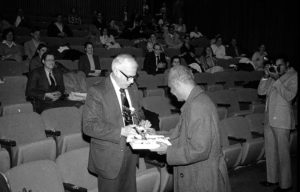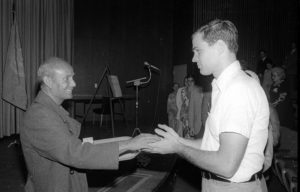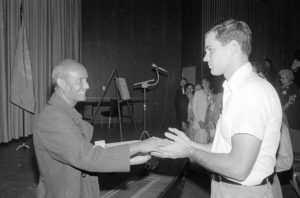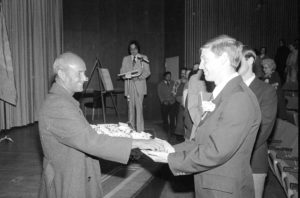A Tribute to the International Red Cross 1979 Jan 23
Filed under MG Members in other events | Tributes and Expressions of appreciation- Deputy Ambassador Mrs. Ruth Garcia-Granados Rosenhouse of Guatemala and
- Mr. Vincent Arlotta, Director of the Queens Chap ter of the American Red Cross.
The programme also featured :
- the performance of a song composed for the Red Cross by Sri Chinmoy,
- a statement from International Red Cross President Alexander Hay and
- a film about the work of the organisation.
MESSAGE TO THE MEDITATION GROUP
FROM MR. ALEXANDER HAY, PRESIDENT, INTERNATIONAL RED CROSS
Since its creation over 110 years ago, the Inter- national Committee of the Red Cross has served the cause of human dignity by protecting and assisting victims of armed conflicts or of international and national disturbances throughout the world.
Since the last World War the Committee’s delegates have 20 visited over 300,000 “political detainees” in an attempt to ensure humane treatment of man by his fellow man.
In a nutshell, the International Committee’s ideal and ultimate purpose is to promote peace around the world. Over the past few years the carrying out of our activities has become increasingly difficult.
Every member of your group can support us morally and help us keep our ideal alive by focusing his consciousness on our efforts and bringing them to the awareness of other people.
Your doing so encourages us to continue in the pursuit of our ideal.
Guest speakers
Mrs. Ruth Garda -Granados de Rosenhouse, Deputy Permanent Representative of Guatemala to the United Nations.
Ladies and gentlemen , it is a great privilege for me to represent the government of my country, Guatemala, in this act of honouring the International Red Cross . I cannot think of any 21 other voluntary agency that has done more to miti- gate the pain and sorrow caused by natural and man-made disasters than the Red Cross Societies of the world. I cannot think either of a setting that embodies more the spirit of the organisation than the Dag Hammarskjold Auditorium of the United Nations. Apolitical, non-sectarian, universal in scope, the Red Cross today symbolises the best of all selfless human impulses. Created to repair the ravages of war, this remarkable organisation has evolved through the years into one of the most complex and sophisticated instruments of the modern world. It is equipped to deal simultaneously with high-level negotiations involving the exchange of prisoners of war, or to organise an emergency team of rescue workers in a remote mining town in Africa or South America. And I cannot omit the Red Cross commitment to human rights. Its record in identi- fying the flagrant violators is highly commendable.
In this respect, we recognise that the Red Cross has always been attuned to the vital issues of the day. Perhaps this flexibility goes a long way in explain- ing why the Red Cross has become one of the most respected and durable institutions of our world. I have a dual debt to the Red Cross Society: first, as a professional in the mental health field, and secondly as a representative of the Government of Guatemala. During my many years as a clinical psychologist I had to appeal to the Red Cross on many occasions on behalf of my patients to help them locate a loved one. I always found under- standing and assistance from the Red Cross. As a representative of Guatemala, I have deep gratitude and admiration for the generous aid that was given our country during the devastating earthquake in 22 1976, when Guatemala was virtually destroyed and over 25,000 people lost their lives and many more lost their homes .
Many of the Red Cross Societies, including that of the Federal Republic of Germany, the Norwegian Red Cross and the Austrian Red Cross, among others, undertook to rebuild entire villages destroyed by the earthquake . Guatemala is also grateful to its own local chapter that supports a number of children’s clinics in the country . To terminate this brief salute to the Red Cross Society , I would like to express my special thanks to the anonymous Red Cross worker : those men and women who risk their lives driving an ambulance in Lebanon, or descending a steep ravine in Guatemala to dig out an Indian family during an earthquake. I believe them to be the real unsung hero es of o ur modern world. Thank you .
Mr. Vincent Ariotta, Director , Queens Chapter of the American Red Cross:
It’s a pleasure to be here today. Normally my remarks would be about the American Red Cross and in particular the 23 American Red Cross in Greater New Yo r k , but today I was asked to speak more ab o ut the in t erna- tional aspects of the Red Cross. There a re several aspects to it.
There is an Interna ti onal Committee which is located in Switzerland and is conducted by up to twenty-five Swiss citizens. The ir p urpose is to protect victims of war in accordance with the Geneva Conventions, which I will go int o a little later on. They also grant recogni ti on to new national Red Cross societies. At t he present time the symbols that represent the societies are the red cross on a white background, the red crescent on a white background, and a red lion and sun on a white background. Also at the present time, Israel is trying to come into this organisation, and the only thing that is holding them out is that they want to use the Star of David . The International Committee does not want to add on to the three emblems that are already in existence , but I think that they will agree , so that in the future we will probably be seeing four different emblems when we display our signs.
They also inspect prisons to see that the prisoners of war are being treated prop- erly, and they direct food packages and mail that comes from home for the prisoners to local Red Cross chapters. They also provide medical supplies in war areas and they have a tracing service whereby members of families can locate displaced people. For example, recently the Vietnamese people were displaced all over the world and even- tually they will be trying to find relatives. Through the International Committee reaching out to the different national societies, they are generally located. Sometimes it takes much longer than expected, but most of the time they are very successful. 24 Another aspect is the League of Red Cross Societies, which comprises a Board of Governors and a delegate from each of the national societies, like the American Red Cross.
Originally our name was American National Red Cross, but we cut out the “national” and it is now the American Red Cross, with over 1,300 individual chapters. The League of Red Cross Societies promotes cooper- ation between the different societies and also coordinates their efforts, especially in time of natural disaster or in relocating refugees. The different societies have experts in different fields.
Normally , when there is a major disaster in Europe, American experts may be called over to help give a hand, especially in the area ?f setting up depots and having supplies flown and shipped in and distributing these supplies to the various groups that will disperse them to the individuals in need.
Then we have the International Convention of the Red Cross. This is the highest deliberating body of the Red Cross. It normally meets every four years and it has representatives from the national societies, from the League of Red Cross Societies, from the International Committee, and also from the governments who have signed the Geneva Conventions. This group ensures unity, so that throughout the whole world the Red Cross is working more or less as one organisation.
The national societies are all chartered by their own individual governments. I mentioned before that they are represented in different ways. Most of the societies use the red cross; the Moslem societies use the red crescent, and Iran uses a red lion and sun. The national societies promote programmes in 25 health, welfare and safety .
In some areas , as in Guatemala , t h ey also provide hospita ls and nursing schoo ls, s et u p clin ics a nd h av e on-going health education programmes . In o ur cou n try normally we d on’ t have hospi tal s set u p and run by Red Cross pe rsonnel. We d o have vo lunt eers at wo rk in hospita ls as aides. They feed t h e eld erly, help people groom the m selves, r ead to peop le who can’t read for whatever reaso n, he lp move patients to areas wh ere they ma y have to go for x- r ays or for different tests . In this way t he y do a j ob that is really appreciated. Now, I mentioned before t h e Ge ne va Conven – tions, and these consis t of fo ur d iff eren t conven- tions.
The first one p r ov id ed pro tection for the wounded and the sick of arm y peLmn el who do battle on land, as we ll as t he doc tors, medical assistants and c haplains of the armed forces on land. T he second conve ntio n dealt with the protect i on of the sick, wounde d an d sh i pwrecked members of the armed forces a t sea . Th e third one dealt with the p rotect ion of prisone rs of war, to see that they are tr eated properly an d n ot abused . It also created a sys t em of inspections whereby they can go in and inspec t the camps to make sure things are being done a ccord ing to t h e co n ferences. The fourth convent ion was to protect civilians in occupied areas, to make sure tha t there is no brutality and that people are being fed and are capable of living in a human way . That more or less comprises the general set-up of the Red Cross as an international organisation.
If I have time, I would like to just go into a few of the things that the American Red Cross of Greater New York does that may be a little different. Our 26 major disasters are fires. Recently it has been reported in the papers about a fire in New Jersey, and this goes on locally, throughout the metro- politan New York area. So, fires really are the major disasters that we contend with on an on-going everyday basis, and occasionally floods. What the Red Cross provides in this field, if it is needed, is shelter, clothing, nursing care, medica- tion and, on occasion, assistance in rehabilitating a home and making sure that the people get back to a state of being as they were before the fire.
Those people that are already receiving monies from our city government are taken care of for the immediate needs of the first day, and then they go to the agency that is already supplying them with some type of assistance. What are the immediate ne eds? In the middle of the night a fire strikes . People are out of their homes. They have just the clothing that is on thei r backs , w hich most of the time is just bed clothes and a b a nket thrown over them. Through the cooperation of t h e Sev e nth Day Adventists, who sto re clothing of all sizes and description , we can provide clothin g . If the fire happens in the daytime and th e re isn ‘t that immediate need, then we write out purchase orde rs to different stores in the area to have the people go and pick up new clothing or whatever their needs are. If they are able to get back into their apartment, the mattress may have been burned. The cause of many fires is people smoking in bed. If that is the only replacement that is needed, we give them a purchase order to go and buy a mattress so that they can return to the apartment. These are some of the extra things that we think of in the field of disaster relief. 27
To be a recogn ised, charte red chapter of th e American Red Cross, we must provide services to servicemen and th eir fam ilies. Since we are not presently in conflict any place and most of the people that are in the armed forces are there on a voluntary basis, there isn’t too great a need for service to military families. But one of the big things that we are working with in that area is trying to help servicemen who have left the service with other than honourable discharges. There is a set method of filling out forms, and certain kinds of documentation that are needed and most people don’t know what it is, whereas our social workers do know the proper procedures. So, in this way the serviceman who is trying to correct his condition does it on a one-shot deal, more or less. It makes the job a lot easier for them. And with the way that the military is thinking today, they change their minds most of the time about the discharge. Now we are going to have a film which will show some of the background of the Red Cross. I thank you for your attention.
Sri Chinmoy offers his gratitude to guest speakers Deputy Permanent Representative of Guatemala Mrs. Rosenhouse and Mr. Vincent Arlotta, Director of the Queens Chapter of the American Red Cross.
A link to transcript in PDF Format from the periodic bulletin “Meditation at the UN” Jan 1979;
for full text bu-scpmaun-1979-01-27-vol-07-n-01-jan-ocr-opt.pdf
“Meditation at the UN” Jan 1979 scanned related pages-images 22 to 32..
- Shraddha
- Shraddha
- Shraddha
- Shraddha
- Shraddha
- Shraddha
- Shraddha
- Shraddha
- Shraddha
